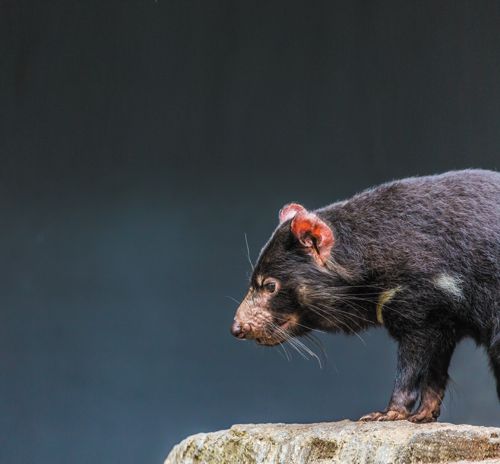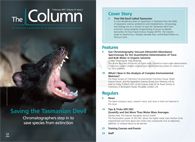That Old Devil Called Tasmanian
A cross-disciplinary team of researchers in Tasmania from the fields of separation science, proteomics and metabolomics, immunology and zoology are on a mission to save the Tasmanian devil from extinction using metabolic fingerprinting of serum to identify biomarkers for Devil Facial Tumour Disease (DFTD). The Column spoke to Naama Karu, Rodrigo Hamede Ross, and Richard Wilson to find out more.
Photo Credit: Curioso/Shutterstock.com

A cross-disciplinary team of researchers in Tasmania from the fields of separation science, proteomics and metabolomics, immunology and zoology are on a mission to save the Tasmanian devil from extinction using metabolic fingerprinting of serum to identify biomarkers for Devil Facial Tumour Disease (DFTD). The Column spoke to Naama Karu, Rodrigo Hamede Ross, and Richard Wilson to find out more.- Interview by Alasdair Matheson
Q. You recently published a paper on discovering biomarkers for cancer in Tasmanian devils (1). Can you tell us how this project arose and why it is important?
Richard Wilson: This project was made possible through a small research grant awarded by the Save the Tasmanian Devil Appeal. The team of researchers from the University of Tasmania (UTas) included members of ACROSS (the Australian Centre for Research on Separation Science) collaborating with the School of Biological Sciences, the Menzies Institute for Medical Research, and the Central Science Laboratory. Metabolomics studies in wild animals are scarce, but despite the challenges involved we now have the first baseline data on the Tasmanian devil metabolome and strong evidence for biomarkers that clearly discriminate between animals with and without facial tumours. This is an important step in the development of a preclinical diagnostic test for this devastating disease.
Q. What are the main obstacles to discovering biomarkers for cancer and for DFTD (Devil Facial Tumour Disease) in Tasmanian devils in particular?
Naama Karu: I can’t testify about general cancer biomarkers. In the case of this project, one obstacle was lack of metabolic information on DFTD, or of cancer in animals, and wild animals in particular. Knowledge gathered on humans cannot be simply translated to animals, and studies in humans have access to larger populations, can gather more metadata on patients, and can control or correct for some of the potentially confounding factors. These were not possible in this study, where samples are collected from wild animals under field conditions, and not upon request. Another issue is the latent stage of DFTD, where an animal is already infected by the transmissible cancer, but hasn’t developed a visible tumour and is therefore yet to be contagious. Devils at the latent stage are of most interest for future development of prediction models; however, they might be confused with healthy subjects. Therefore, the control animals were considered healthy only if they haven’t developed tumours for at least six months after the examined sample was taken. This substantially limited the study design and reduced the sample size. A positive point in DFTD research is that the cancer tumours are mostly visible and can be visually measured, hence the progress of the disease is monitored non-invasively, apart from internal metastasis expected in advanced DFTD. The location of the tumours on the face of the devils means that their ability to feed might be affected, and this introduces a possible indirect effect on metabolites. Although devils with advanced DFTD (large tumours) did not show obvious signs of malnutrition, the biological interpretation of the results had to take this option into consideration.
Q. How do you go about getting samples from an endangered species?
Rodrigo Hamede Ross: Working with wildlife is always a big responsibility, particularly with endangered species. The techniques we have developed for trapping and sampling Tasmanian devils have been refined over a 20-year period and continues to be refined by our research team. Fortunately, the Tasmanian devil is an ideal species to work with because they have high recapture rates, they can be handled without the need to use anaesthetics (which makes sampling far less invasive), and their stress at being handled diminishes with increasing number of repeat captures. Because our study is longitudinal and we monitor the study population at three-month intervals, most individuals are regularly captured throughout their life and are therefore used to our field protocols.
Q. Was there anything novel about your approach from an analytical perspective?
NK: No, we have applied standard protocols for sample preparation and liquid chromatography–mass spectrometry (LC–MS) analysis, as established for human serum metabolomics. In hindsight, we should have made some modifications in sample preparation and chromatography. The Tasmanian devils are carnivores, and this, among other reasons, makes the profile of their serum different from humans. The sample preparation could benefit from fineâtuning in terms of the protein precipitation procedure. Also, the amount of lipids in the prepared samples was very high compared with humans, and this caused chromatography problems. Despite the use of a guard column, the analytical column had to be washed with stronger solvents (methanol:hexane mix) more frequently than required in human serum studies. Perhaps a lipid extraction step in the sample preparation could eliminate this problem, but that would be at the expense of finding potential biomarkers from this class. Also, splitting of the LC effluent before entry to the ESI source (from 0.4 mL/min to 0.15 mL/min) was necessary to reduce background noise and allow longer batches before source cleaning was required.
Q. Do you have any practical advice for chromatographers embarking on biomarker discovery research based on your experiences from this project?
NK: Don’t be tempted to take any shortcuts: allow extra budget and time for unexpected issues that will arise; be aware that data analysis can take up to 90% of the project time; employ or at least consult with a statistician on study design and data analysis, with a bioinformatician on data preanalysis, and a biochemist on biological interpretation of metabolic findings; have a practical and statistically appropriate LC–MS batch plan, with ample runs of pooled QC replicates; conduct a few MS/MS acquisitions for each batch if you do not plan to run all the samples in MS/MS mode (easier for immediate analysis before planned MS/MS runs later on); apply strict filtration rules such as intensity and signal-to-noise (S/N) threshold and inspect the MS peaks manually to eliminate noise peaks, which can heavily affect multivariate models; explore models ruled by potentially confounding factors, to see which metabolites might not be good biomarker candidates for the study, or will need to be corrected for the factor.
Q. What other challenges did you face in this project (and how did you overcome them)?
NK: This is the first LC–MS metabolomics study on Tasmanian devils altogether. This means that we gathered an overwhelming amount of metabolite data and did not have any reference to compare our findings to. Therefore, a cautious approach of data screening was taken, including individual inspection of LC–MS peaks to validate each feature and create a first Tasmanian devil metabolome “bank”. Only then could the real work start, applying the standard procedures for exploratory metabolomics data analysis. Another major obstacle was the nonideal sample availability, dictated by trapping of wild animals and by the profile of the disease (hardly any healthy adults; more healthy young females than males). I have taken additional statistical analysis steps to identify metabolites affected by potentially confounding factors. Future models for detection of DFTD in the latent stage must correct for these factors or eliminate the use of such metabolites.
Q. Is there anything you would like to comment on regarding the multivariate modelling?
NK: Multivariate modelling was utilized for selection of metabolites, based on an age-matched subsample (“training set”). As explained in the paper, I tried to follow good statistical analysis practice as well as conform to leading published work in the metabolomics field. The general approach in the search of biomarkers for early detection of cancer is that inclusion of false biomarkers is better than exclusion of potentially true biomarkers. Nevertheless, it took some self-restriction not to get carried away, and inclusion rules were applied on the account of quantity of potential biomarkers. More multivariate analysis was then used to demonstrate how models developed for the training set using the selected metabolites could predict the health status in the test set. I thought that using various models would increase the credibility of the findings, although I am aware that there were still limitations of sample size and confounding factors such as sex, season, and diet status. It is important to mention that refining multivariate models by feature selection (which is dictated by the same models) is controversial in the eye of some statisticians. This is an issue that needs to be addressed, not only in the metabolomics field, but also in the more established “omics” fields, which we inherited the common methods from.
Q. What were your main findings?
NK: We found a set of metabolites that were significantly different in devils with DFTD. Some may be directly related to the cancer, while others may reflect downstream metabolic changes. Either way, this first metabolomics knowledge on Tasmanian devils can aid in further biochemistry research into the disease. The potential DFTD biomarkers found in this study would have to be further demonstrated in DFTD cell culture to prove their direct relation to the disease.
RW: One of the striking characteristics of the dataset was the large number of peptides associated with DFTD samples. The high correlation between the peptides led us to establish that they were derived not only from the same protein (fibrinogen alpha), but also from a specific amino-terminal subdomain of that protein. So, while this was essentially a metabolomics study, methods more commonly associated with proteomics, such as software for protein database searching and de novo peptide sequencing, were also required.
Q. What is the next stage for this project?
NK: Finalize a prediction model for DFTD in the latent stage, and then (pending funding) conduct metabolomics analysis on new serum samples from different populations and test the model. We would also like to profile the metabolome of semi-wild healthy adults on Maria Island (part of the insurance population programme).
RW: Further analysis using shotgun proteomics to generate a DFTD-specific protein signature would complement the current study. As we have a comprehensive set of longitudinal samples there is potential to discover novel biochemical aspects of the disease progression. If anyone has developed reagents for removal of high abundance proteins from marsupial serum we would be very interested in hearing from you!
Q. How can people help with this campaign?
NK: You can donate to the research on the Tasmanian devil via the “Save the Tasmanian Devil” appeal, which supported our study. See www.tassiedevil.com.au
Reference
1. N. Karu, R. Wilson, R. Hamede, M. Jones, G.M. Woods, E.F. Hilder, and R.A. Shellie, J. Proteome Res.15(10), 3827–3840 (2016).

Naama Karu is a postdoctoral researcher in the Wishart group and the metabolomics innovation centre (TMIC) at the University of Alberta, Canada. During 2012–2015, as a postdoctoral research fellow in ACROSS, the University of Tasmania, Naama took part in several LC–MS metabolomics projects, mainly in the biomedical field. She is an analytical chemist with a background in biochemistry.

Richard Wilson is a senior research fellow and manages the University of Tasmania proteomics core facility, located in the Central Science Laboratory at UTas. He is a biochemist with over a decade of experience in the application of proteomics in a wide range of biological contexts.

Rodrigo Hamede Ross is a postdoctoral researcher and ARC – DECRA fellow working on the ecology, epidemiology, and evolution of infectious diseases. He is a disease ecologist with more than 12 years of experience working with Tasmanian devils and devil facial tumour disease. He has developed national and international research collaborations to understand the impact of the disease in the wild and improve the conservation prospects of the species.

New Study Reviews Chromatography Methods for Flavonoid Analysis
April 21st 2025Flavonoids are widely used metabolites that carry out various functions in different industries, such as food and cosmetics. Detecting, separating, and quantifying them in fruit species can be a complicated process.
Common Challenges in Nitrosamine Analysis: An LCGC International Peer Exchange
April 15th 2025A recent roundtable discussion featuring Aloka Srinivasan of Raaha, Mayank Bhanti of the United States Pharmacopeia (USP), and Amber Burch of Purisys discussed the challenges surrounding nitrosamine analysis in pharmaceuticals.
Silvia Radenkovic on Building Connections in the Scientific Community
April 11th 2025In the second part of our conversation with Silvia Radenkovic, she shares insights into her involvement in scientific organizations and offers advice for young scientists looking to engage more in scientific organizations.








